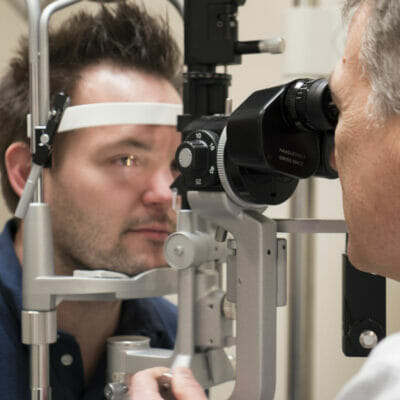Early detection is the key to effective glaucoma treatment.
Glaucoma is the second leading cause of blindness worldwide but many people who have the disease don’t even know it. For this reason, it’s often considered a silent disease like hypertension. Glaucoma can gradually lead to vision loss, beginning in the periphery of one’s eyesight and later involving central vision. Prevention is key.
At Piedmont Eye Center, we have the latest technology to help detect and monitor this challenging disease. Advanced treatment options allow us to prevent unnecessary vision loss including blindness.
Dr. Elizenda Ceballos and Dr. James Paauw are the area’s only glaucoma trained specialists who can provide this level of specialized care. If it’s been a while since you have been screened for this serious eye disease, please call today for your appointment.

FAQ
What is glaucoma?
There are many types of glaucoma. Most types are associated with high eye pressure (intraocular pressure). Other types, known as “low tension” or “normal tension” glaucoma are not associated with high eye pressure. The most common type of glaucoma associated with elevated pressure is called “primary open angle glaucoma” or POAG. In this case, the elevated eye pressure causes damage to the optic nerve, which is an important structure that carries visual information from the eye to the brain. As nerve damage progresses, vision is irreversibly lost. In the vast majority of cases, there is no eye pain or other symptoms to indicate a problem. Therefore, most people with undiagnosed glaucoma do not realize something is wrong until the advanced stages of the disease. The lack of symptoms has earned glaucoma the reputation of being the “silent thief of sight.” Early detection and treatment are critical to preserving sight. The best way to detect glaucoma is through a complete eye examination.
What’s the difference between glaucoma and ocular hypertension?
Ocular hypertension (OHT) is a condition in which there is elevated intraocular pressure but no evidence of optic nerve damage. Some patients never develop damage, whereas some do progress to glaucoma. All patients with OHT need regular follow-ups since there is no way to predict who will develop nerve damage and vision loss.
Who’s at the most risk for glaucoma?
Anyone can develop glaucoma at any age. However, people over age 60, African-Americans, highly nearsighted individuals, those with diabetes, history of eye trauma, or a family history of glaucoma are at higher risk than the average person.
What are the early signs and symptoms of glaucoma?
There are no reliable early signs of glaucoma, and any damage that occurs is irreversible. This is why it is so important to have regular eye exams. The earlier the condition is detected, the better the odds of preserving vision.
Is glaucoma curable?
Although glaucoma is not curable, it is treatable. Glaucoma treatment is highly effective and can slow down or stop the progression of the disease. With early diagnosis and treatment, most people with glaucoma can retain their vision long-term.
What glaucoma treatments are currently available?
There are a variety of prescription eye drops that are used to reduce intraocular pressure. These drops are used one or several times a day, depending on the medication. Laser surgery can also be used alone or in combination with drops to help lower the eye pressure. In cases where drops of laser cannot get to the eye pressure low enough, surgery may be necessary and usually can be performed as an outpatient procedure.
Online resources
Glaucoma Research Foundation: www.glaucoma.org
The Glaucoma Foundation: www.glaucomafoundation.org
American Glaucoma Society: www.glaucomaweb.org